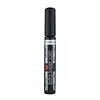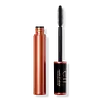What's inside
What's inside
 Key Ingredients
Key Ingredients

No key ingredients
 Benefits
Benefits

 Concerns
Concerns

 Ingredients Side-by-side
Ingredients Side-by-side

Water
Skin ConditioningParaffin
PerfumingGlyceryl Stearate
EmollientCopernicia Cerifera Cera
EmollientPvp
Emulsion StabilisingCera Alba
EmollientC18-36 Acid Triglyceride
EmollientPropylene Glycol
HumectantPolysorbate 20
EmulsifyingStearic Acid
CleansingAcrylates Copolymer
Panthenol
Skin ConditioningCaprylyl Glycol
EmollientHydroxyethylcellulose
Emulsion StabilisingTocopheryl Acetate
AntioxidantTalc
AbrasiveSodium Hydroxide
BufferingAscorbyl Glucoside
AntioxidantCalcium Aluminum Borosilicate
Gossypium Herbaceum Powder
AbsorbentHydrolyzed Wool
HumectantSerica Powder
Skin ConditioningRetinyl Palmitate
Skin ConditioningHdi/Trimethylol Hexyllactone Crosspolymer
Acrylates/Carbamate Copolymer
Skin ConditioningHydrogenated Vegetable Oil
EmollientSilica
AbrasiveGlycerin
HumectantHydrogenated Olive Oil
Skin ConditioningOlea Europaea Fruit Oil
MaskingEthylene/Methacrylate Copolymer
Collagen
MoisturisingPrunus Armeniaca Kernel Oil
MaskingColloidal Gold
AntimicrobialSaccharomyces/Platinum Ferment
Skin ConditioningSaccharomyces/Silver Ferment
Skin ConditioningCeramide Ns
Skin ConditioningHydrolyzed Keratin
HumectantOlea Europaea Oil Unsaponifiables
Skin ConditioningSodium Sulfate
Isopropyl Titanium Triisostearate
EmollientPhalaenopsis Lobbii Extract
BleachingPotassium Sorbate
PreservativePhenoxyethanol
PreservativeBambusa Arundinacea Leaf Extract
Skin ConditioningSodium Benzoate
MaskingTocopherol
AntioxidantChlorphenesin
AntimicrobialSorbic Acid
PreservativeCI 75470
Cosmetic ColorantCI 77289
Cosmetic ColorantCI 77288
Cosmetic ColorantCI 77266
Cosmetic ColorantCI 77510
Cosmetic ColorantIron Oxides
Mica
Cosmetic ColorantCI 77891
Cosmetic ColorantCI 77007
Cosmetic ColorantWater, Paraffin, Glyceryl Stearate, Copernicia Cerifera Cera, Pvp, Cera Alba, C18-36 Acid Triglyceride, Propylene Glycol, Polysorbate 20, Stearic Acid, Acrylates Copolymer, Panthenol, Caprylyl Glycol, Hydroxyethylcellulose, Tocopheryl Acetate, Talc, Sodium Hydroxide, Ascorbyl Glucoside, Calcium Aluminum Borosilicate, Gossypium Herbaceum Powder, Hydrolyzed Wool, Serica Powder, Retinyl Palmitate, Hdi/Trimethylol Hexyllactone Crosspolymer, Acrylates/Carbamate Copolymer, Hydrogenated Vegetable Oil, Silica, Glycerin, Hydrogenated Olive Oil, Olea Europaea Fruit Oil, Ethylene/Methacrylate Copolymer, Collagen, Prunus Armeniaca Kernel Oil, Colloidal Gold, Saccharomyces/Platinum Ferment, Saccharomyces/Silver Ferment, Ceramide Ns, Hydrolyzed Keratin, Olea Europaea Oil Unsaponifiables, Sodium Sulfate, Isopropyl Titanium Triisostearate, Phalaenopsis Lobbii Extract, Potassium Sorbate, Phenoxyethanol, Bambusa Arundinacea Leaf Extract, Sodium Benzoate, Tocopherol, Chlorphenesin, Sorbic Acid, CI 75470, CI 77289, CI 77288, CI 77266, CI 77510, Iron Oxides, Mica, CI 77891, CI 77007
Water
Skin ConditioningParaffin
PerfumingGlyceryl Stearate
EmollientSynthetic Beeswax
Emulsion StabilisingStearic Acid
CleansingAcacia Senegal Gum
MaskingButylene Glycol
HumectantPalmitic Acid
EmollientPolybutene
Oryza Sativa Bran Wax
Skin ConditioningVp/Eicosene Copolymer
Ozokerite
Emulsion StabilisingAminomethyl Propanol
BufferingHydrogenated Vegetable Oil
EmollientPhenoxyethanol
PreservativeStearyl Stearate
EmollientHydroxyethylcellulose
Emulsion StabilisingTropolone
Skin ConditioningCI 77499
Cosmetic ColorantCI 77007
Cosmetic ColorantWater, Paraffin, Glyceryl Stearate, Synthetic Beeswax, Stearic Acid, Acacia Senegal Gum, Butylene Glycol, Palmitic Acid, Polybutene, Oryza Sativa Bran Wax, Vp/Eicosene Copolymer, Ozokerite, Aminomethyl Propanol, Hydrogenated Vegetable Oil, Phenoxyethanol, Stearyl Stearate, Hydroxyethylcellulose, Tropolone, CI 77499, CI 77007
Ingredients Explained
These ingredients are found in both products.
Ingredients higher up in an ingredient list are typically present in a larger amount.
This pigment is called Ultramarine blue lazurite. It gives a saturated blue color, but can be used to create other colors as well.
According to the manufacturer, it is usually made from kaolin, sodium sulfate, sodium carbonate, sulfur, and charcoal.
Glyceryl Stearate is a mix of glycerin and stearic acid.
It is used to stabilize the mixing of water and oil ingredients. By preventing these ingredients from separating, it can help elongate shelf life. It can also help thicken the product's texture.
As an emollient, it helps soften skin and supports barrier-replenishing ingredients.
In cosmetics, Glyceryl Stearate is often made from vegetable oils or synthetically produced.
This ingredient may not be fungal-acne safe
Fun fact: The human body also creates Glyceryl Stearate naturally.
Learn more about Glyceryl StearateHydrogenated Vegetable Oil is created by adding hydrogen to vegetable oil in order to give it more stability. This process also raises the melting point of vegetable oil. In cosmetics, it is an emollient.
Emollients help soothe and soften the skin. They do this by creating a protective film on your skin. This barrier helps trap moisture and keeps your skin hydrated. Emollients may be effective at treating dry or itchy skin.
The term "Hydrogenated Vegetable Oil" is an umbrella term and can refer to a variety of vegetable oils and blends of: sunflower oil, soybean oil, olive oil, coconut oil, palm oil, and more.
Due to the differences in vegetables, the benefits may vary.
Learn more about Hydrogenated Vegetable OilHydroxyethylcellulose is used to improve the texture of products. It is created from a chemical reaction involving ethylene oxide and alkali-cellulose. Cellulose is a sugar found in plant cell walls and help give plants structure.
This ingredient helps stabilize products by preventing ingredients from separating. It can also help thicken the texture of a product.
This ingredient can also be found in pill medicines to help our bodies digest other ingredients.
Learn more about HydroxyethylcelluloseParaffin is a solid created from petroleum. The term 'paraffin' can also refer to either
petroleum jelly or mineral oil.
It has natural occlusive properties which can worsen oily skin. Due to its petrolatum base, this ingredient is not fungal-acne safe.
Phenoxyethanol is a preservative that has germicide, antimicrobial, and aromatic properties. Studies show that phenoxyethanol can prevent microbial growth. By itself, it has a scent that is similar to that of a rose.
It's often used in formulations along with Caprylyl Glycol to preserve the shelf life of products.
Stearic Acid is a fatty acid. It is an emollient, emulsifier, and texture enhancer.
As an emollient, stearic acid helps soften skin. It aids the skin's protective barrier by preventing water loss. It also provides a gentle cleansing effect without stripping away natural oils.
Stearic acid may also be used to enhance the texture of products. It can add volume and stabilize ingredients such as water and oil. This can help water and oil ingredients from separating.
Sources of stearic acid include animal or vegetable fats/oils such as coconut or shea. It can be naturally found in butter, cocoa butter, shea butter, vegetable fats, and animal tallow.
This ingredient may not be Malassezia folliculitis, or fungal-acne safe.
Learn more about Stearic AcidWater. It's the most common cosmetic ingredient of all. You'll usually see it at the top of ingredient lists, meaning that it makes up the largest part of the product.
So why is it so popular? Water most often acts as a solvent - this means that it helps dissolve other ingredients into the formulation.
You'll also recognize water as that liquid we all need to stay alive. If you see this, drink a glass of water. Stay hydrated!
Learn more about Water